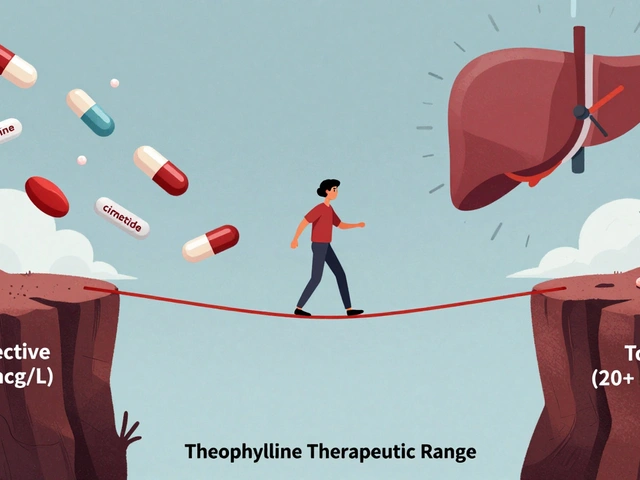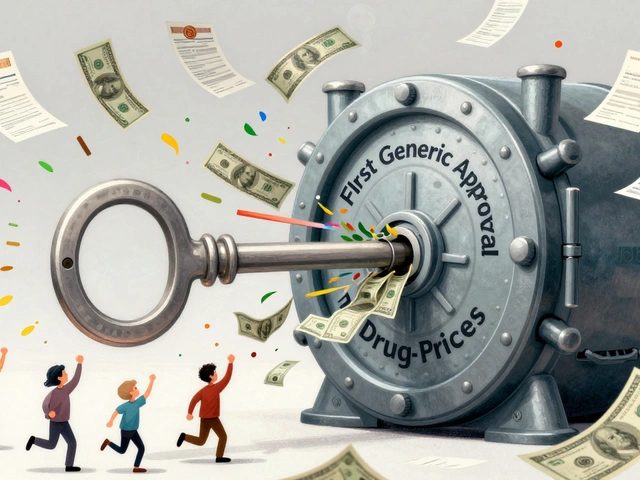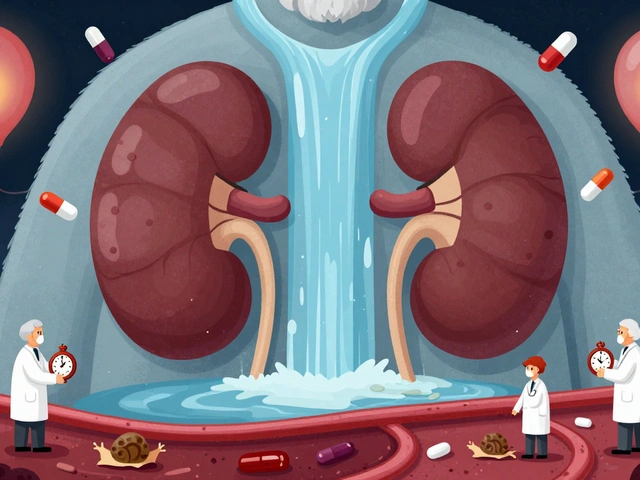
Pioglitazone has been a go-to drug for type 2 diabetes for years, but it’s not always the best fit for everyone. Some people run into side effects, or maybe they’re worried about long-term safety. Others just want options—maybe something gentler on the body, or easier to combine with other meds.
Good news: 2025 brings more choices than ever before. If pioglitazone isn’t working out for you, or your doctor says it’s time to rethink your medication, you’ve got real alternatives. These days, the conversation isn’t just about controlling blood sugar. It’s about staying healthy in the big picture—heart health, weight, convenience, and cost all matter, too.
Let’s walk through what’s available, starting with the most talked-about options. You’ll get the pros and cons of each, some practical advice, and a side-by-side comparison to help you figure out what’s a good fit for your situation.
- Why Look Beyond Pioglitazone?
- Rosiglitazone (Avandia)
- Metformin
- SGLT2 Inhibitors
- GLP-1 Receptor Agonists
- DPP-4 Inhibitors
- Sulfonylureas
- Insulin Therapy
- The Takeaway: Comparing Your Options
Why Look Beyond Pioglitazone?
So you’ve heard about Pioglitazone alternatives, and maybe you’re wondering why anyone would need another option. Pioglitazone has been popular for type 2 diabetes because it ramps up insulin sensitivity and lowers blood sugar, but it’s not a one-size-fits-all fix.
First off, this drug can lead to weight gain. For a lot of folks already dealing with diabetes, that’s a real problem. Extra pounds can make insulin resistance worse and put more strain on your heart. Second, there’s the risk of water retention. That might not sound like much, but it can cause or worsen swelling, and for people with heart issues, it can turn into heart failure.
There’s more. Pioglitazone has been linked with an increased risk of bone fractures, especially for women. Some studies also hint at a higher risk of bladder cancer, though the data isn’t rock-solid. And don’t forget—if you have liver problems, you’ll probably be checking in with your doctor a lot to watch for possible side effects.
Convenience plays a part, too. As new diabetes medications pop up, people want drugs that fit easily into their lives—once-daily tablets, less hassle, or even combo pills that tackle blood sugar and weight at the same time. Cost can’t be ignored either, as some people just can’t afford lifelong meds that are under patent or not available in generic versions.
If you’re someone who’s had issues with Pioglitazone—or you’re just looking ahead for what’s new in diabetes care—the alternatives are worth considering. Here’s a quick side-by-side snapshot showing where pioglitazone stands with some common worries:
| Concern | Pioglitazone |
|---|---|
| Weight gain | Common risk |
| Fluid retention | Common, can be serious |
| Bone fracture risk | Increased, especially for women |
| Heart failure | May worsen condition |
| Bladder cancer | Possible risk |
| Liver monitoring | Recommended |
Your doctor can help you weigh these trade-offs, but knowing what’s out there means you can bring good questions to your next appointment.
Rosiglitazone (Avandia)
Rosiglitazone, also known by its brand name Avandia, is one of the main pioglitazone alternatives for type 2 diabetes. Like pioglitazone, it belongs to the thiazolidinedione (TZD) family, and it works by activating PPAR-γ receptors. This action helps muscle, fat, and liver cells respond better to insulin, which means blood sugar can be lowered without producing more insulin. If you've had trouble with metformin or just need a different option for insulin sensitivity, rosiglitazone might be worth asking about.
When doctors first started prescribing rosiglitazone back in the early 2000s, it was a big hit for its blood sugar-lowering power. But over time, researchers noticed some serious downsides—it raised the risk of heart problems in a few groups of people. That led to safety warnings and a lot of debate. In 2013, the FDA eased some of those restrictions since new studies suggested the heart risks weren’t as high for everyone, but careful monitoring is still the rule.
Pros:
- Improves insulin sensitivity, which helps get blood glucose under control even when your body's own insulin is not working well.
- Available in generic forms, so it's more affordable than many newer diabetes medications.
- Once-daily dosing—makes it simple to work into a daily routine.
Cons:
- Risk of weight gain. Some patients gain several pounds, and for folks already trying to lose weight, that’s a big drawback.
- Linked to higher cardiovascular event risks, especially in people with existing heart conditions or risk factors for heart failure.
- It's not for people with heart failure—doctors avoid it in anyone with moderate or severe heart failure, per guidelines.
- Liver monitoring is required since, on rare occasions, serious liver issues have been reported.
Doctors usually start low and go slow with rosiglitazone, especially if there are any concerns about the heart. If you have a heart condition, it’s a conversation you’ll have to have with your doctor before even thinking about this med.
One interesting stat: according to a review published in Diabetes Care, patients on rosiglitazone can see A1C drops of around 1–1.5%, which is roughly what you'd expect from pioglitazone as well. So, you don’t lose out on sugar control if you’re switching between the two—just keep an eye on possible side effects.
| Feature | Rosiglitazone |
|---|---|
| Once-daily dosing | Yes |
| Risk of weight gain | Moderate to high |
| Heart safety concerns | Present (monitor closely) |
| Liver monitoring | Required |
| Generic available | Yes |
At the end of the day, rosiglitazone gives you another shot at improving insulin sensitivity if pioglitazone isn't right. Just make sure you’re aware of the risks and have regular checkups to catch any issues early.
Metformin
When people start talking about diabetes meds, metformin is usually the first name that pops up, and for good reason. It’s been around for decades, and there’s a mountain of research backing it up. Doctors often start with metformin before turning to anything else, especially for folks with type 2 diabetes.
What makes metformin stand out? First, it helps your body use insulin more effectively. It stops your liver from pumping out more glucose than you need, and it even helps your muscles soak up extra sugar from your blood. Most people take it as a pill once or twice a day, so it’s easy to fit into a daily routine.
| Benefit | Fact |
|---|---|
| Blood Sugar | Averages a 1-2% drop in A1C |
| Weight | Not linked to weight gain |
| Heart Health | Certain studies show less risk for heart problems |
Unlike pioglitazone or other “glitazones,” metformin isn’t connected to weight gain—some people even lose a couple pounds. That's a big deal if you’re tracking your numbers or have other health goals. Metformin also rarely causes low blood sugar by itself, so you don’t have to stress about sudden crashes if you miss a meal.
Pros
- First-line drug: Doctors trust it for starting diabetes care.
- Usually does not cause weight gain; might help you lose a bit.
- Low risk of hypoglycemia unless paired with other meds.
- Generic, so it’s cheap—even without insurance.
- Some research hints at heart protection.
Cons
- Can cause stomach issues, like nausea or diarrhea, for some people.
- Not great for folks with serious kidney problems.
- Rarely, people get a vitamin B12 deficiency after taking it a long time.
- Doesn’t work for type 1 diabetes (needs some insulin to work).
Quick tip: If metformin upsets your stomach, ask your doctor about the extended-release version. Many people find it's a lot easier to handle.
For a lot of people living with diabetes, metformin is an easy choice—cheap, proven, and pretty safe. But if you’ve got kidney issues, or it’s just not getting the job done, there are plenty of other meds to look at.
SGLT2 Inhibitors
If you’re looking for something that works differently from pioglitazone but still helps manage type 2 diabetes, SGLT2 inhibitors are hard to ignore in 2025. Big names in this family include empagliflozin (Jardiance), dapagliflozin (Farxiga), and canagliflozin (Invokana). Instead of messing with insulin signals, these meds force your kidneys to dump extra sugar straight into your urine. Simple, but effective—especially if you’re dealing with high blood sugar that just won’t budge.
Doctors like these drugs partly because they come as easy-to-use pills. More importantly, recent studies show real benefits for heart health. People on an SGLT2 inhibitor see lower rates of heart failure and kidney problems, which isn’t something every diabetes med can claim. You’ll often see them added when someone also has high risk for heart troubles.
Want to see how SGLT2 inhibitors stack up?
- Lower blood sugar without causing low blood sugar (or "hypos") often
- Help with weight loss—a nice bonus if you’re struggling with extra pounds
- Reduce risk of serious heart problems and protect kidneys, according to multiple clinical studies
- Usually once-daily dosing, making them easy to work into a routine
There are downsides to consider, though. SGLT2 inhibitors make you pee out more sugar, so expect to run to the bathroom more often. Some people get more urinary tract or yeast infections. And if you don’t drink enough water, you could get dehydrated.
- Not ideal if you have frequent urinary infections or kidney issues
- Can cause a drop in blood pressure—something to watch if you tend to feel lightheaded
- Rare risk of a serious problem called diabetic ketoacidosis, especially if you skip meals or get sick
- Usually pricier than basic generics, though insurance may help
Here’s a handy table showing how SGLT2 inhibitors compare to pioglitazone on some key points:
| Feature | SGLT2 Inhibitors | Pioglitazone |
|---|---|---|
| Main Action | Kidneys remove sugar through urine | Cells more sensitive to insulin |
| Weight Impact | Usually weight loss | Often weight gain |
| Heart Benefits | Reduced heart failure risk | Some concern over heart risks |
| Hypo Risk | Very low | Low |
| Side Effects | More bathroom trips, UTIs, rare ketoacidosis | Fluid retention, bone fractures, bladder cancer risk |
| Cost | Often expensive | Generic available |
If you have extra reasons to protect your heart or kidneys beyond just lowering blood sugar, SGLT2 inhibitors might be a strong fit. But like always, talk to your doctor to see if they match your personal health picture.

GLP-1 Receptor Agonists
If you're searching for something that tackles blood sugar and helps with weight management, GLP-1 receptor agonists are worth a look. These meds, like semaglutide (Ozempic, Wegovy) and liraglutide (Victoza, Saxenda), work by mimicking a natural hormone that boosts insulin release when your blood sugar climbs. They're not just another pill—most come in easy-to-use weekly pens.
Doctors have warmed up to GLP-1 agonists big time in recent years. Why? Because they do double duty: drop blood sugar and take a swing at extra pounds. The American Diabetes Association now suggests GLP-1s as a top-tier option if you need to lower your A1C and you want to lose weight.
What about real results? Studies show that semaglutide can lower A1C by up to 1.5% and help people lose 10% of their body weight after a year. Plus, these drugs have been shown to reduce risk of heart attacks and strokes in folks with type 2 diabetes and heart disease.
Pros
- Strong A1C-lowering effect, often better than pioglitazone
- Promotes weight loss instead of gain
- Some types reduce risk of heart attack and stroke
- Once-weekly dosing is possible with most brands
Cons
- Usually given by injection (though oral semaglutide is available)
- Can cause nausea, especially in the first few weeks
- Some options can be pricey—insurance coverage matters
- Not right if you've had certain thyroid tumors or pancreatitis before
| Drug Name | Typical A1C Drop | Avg. Weight Loss (Year) | Dosing |
|---|---|---|---|
| Semaglutide (Ozempic, Wegovy) | 1.0-1.5% | 10% | Weekly |
| Liraglutide (Victoza, Saxenda) | 0.9-1.3% | 5-7% | Daily |
Tip: Start low and go slow with the dose. Most nausea fades after a few weeks, and eating smaller meals helps.
If your main concern is balancing blood sugar with weight goals—and you're okay with a shot once a week—GLP-1s could be the most modern option out there.
DPP-4 Inhibitors
DPP-4 inhibitors are a pretty popular choice if you’re looking for a Pioglitazone alternative that keeps things simple. You’ll see names like sitagliptin (Januvia), saxagliptin (Onglyza), linagliptin (Tradjenta), and alogliptin listed. These pills work by blocking an enzyme called dipeptidyl peptidase-4 (or DPP-4 for short). When this enzyme is blocked, your body gets a little help to make more insulin after meals and less sugar from your liver—and that helps keep blood sugar in check.
DPP-4 inhibitors are favorites for people who want something that doesn’t cause weight gain, isn’t likely to trigger low blood sugar, and is easy to take—usually a single daily pill. They slide smoothly into daily life, so you won't have to overhaul your routine. Plus, they’re okay to mix and match with most other diabetes drugs, including Metformin or SGLT2 inhibitors.
Pros
- Low risk of causing hypoglycemia (low blood sugar), especially compared to sulfonylureas.
- No significant impact on body weight—some people even see a tiny bit of weight loss.
- Generally well-tolerated with mild side effects, if any.
- Most options are once-daily pills, which is convenient.
- Can be taken alone or with other diabetes medications for better control.
Cons
- Might not lower blood sugar as strongly as GLP-1 receptor agonists or insulin, especially if blood sugars are way up there.
- Some reports link DPP-4 inhibitors to a slight risk of joint pain, and in rare cases, pancreatitis.
- Usually more expensive than older drugs or generics (like metformin).
- Insurance coverage can be a headache—always double-check your plan.
Here’s a quick look at A1C reduction data from real-world studies in 2024. For most people, DPP-4 inhibitors cut A1C by 0.5–0.8% on average:
| DPP-4 Inhibitor | Approx. A1C Reduction (%) |
|---|---|
| Sitagliptin | 0.7 |
| Linagliptin | 0.6 |
| Saxagliptin | 0.7 |
| Alogliptin | 0.6 |
If you want steady blood sugar control without surprises, DPP-4 inhibitors are worth chatting with your doctor about. They’re not magic, but for lots of folks, they just work—quietly and without much hassle.
Sulfonylureas
If you ask older doctors about diabetes meds, they'll almost always mention sulfonylureas. These are some of the oldest and most tried-and-true oral medicines out there for type 2 diabetes. Folks still use them when newer options don’t fit or when cost is a big worry. Examples you might hear about include glipizide, glyburide, and glimepiride. They all work by helping your pancreas pump out more insulin, which brings blood sugar down. That’s especially handy when your body still makes some insulin, but it’s not enough on its own.
Compared to Pioglitazone alternatives like SGLT2 inhibitors or GLP-1 medications, sulfonylureas have a low price tag. Pharmacies usually stock generic versions, so insurance or out-of-pocket costs rarely break the bank. They work fast (often within hours), making them a go-to choice if you need quick blood sugar control while waiting for other meds to kick in.
Pros
- Very affordable–a month’s supply often costs less than lunch.
- Years of safety data; doctors know what to expect.
- Simple dosing; most are once a day, but some may be split morning and evening.
- Works fast to lower blood sugar.
Cons
- Hypoglycemia (low blood sugar) is more common with sulfonylureas than most other diabetes drugs.
- Can cause weight gain—a problem for a lot of folks managing diabetes.
- Loses effectiveness over time, especially if your body makes less insulin as the years pass.
- Not ideal if you have kidney or liver issues.
| Sulfonylurea | Typical Starting Dose (mg/day) | Cost per Month (USD) | Major Side Effect |
|---|---|---|---|
| Glipizide | 5 | 5-10 | Hypoglycemia |
| Glimepiride | 1 | 5-10 | Weight Gain |
| Glyburide | 2.5 | 5-10 | Hypoglycemia |
If you’re shopping for Pioglitazone alternatives and you want something simple, affordable, and fast-acting, sulfonylureas deserve a look. But talk with your provider about the real risk of low blood sugars, especially if you’re older, eating less, or mixing meds. Keeping some juice or glucose tablets handy when you start is a smart move.
Insulin Therapy
When you think about treating diabetes, insulin therapy feels like the classic move. No surprise—insulin’s been saving lives for over a century. It’s not just for type 1 diabetes; more type 2 folks are using it, especially if pills (like Pioglitazone alternatives) don’t keep blood sugar in check.
Insulin comes in all sorts: fast-acting for mealtime spikes, long-acting to keep you steady overnight and in between meals, and mixes for folks who want fewer shots. Your doctor usually picks the type based on your daily routine, eating habits, and how your blood sugar readings look.
"Insulin remains the single most effective medication for lowering glucose and can be tailored to a patient’s needs and preferences." – American Diabetes Association 2025 Guidelines
Here’s something interesting: Nearly 30% of people with type 2 diabetes in the U.S. add insulin at some point to get better control. And insulin pens are wildly popular now—they’re easy, less painful, and more discreet than the old-school vials and syringes.
| Type | Onset | Duration |
|---|---|---|
| Rapid-acting | 15 minutes | 2-4 hours |
| Short-acting | 30 minutes | 3-6 hours |
| Long-acting | 1-2 hours | Up to 24 hours |
Pros
- Works for any stage of diabetes, no matter how advanced
- Fast and reliable blood sugar control
- Lots of types—can match almost any schedule
- Most insurance plans cover the basics
Cons
- Daily injections needed—can feel like a hassle
- Risk of low blood sugar if dosed too high or you miss meals
- Can cause weight gain, especially at higher doses
- Still pricey without good insurance, especially brand-name pens or pumps
Some people worry about starting insulin, thinking it’s only for “last resort.” That’s old thinking. If you can’t hit your targets—or want more flexibility—it’s a solid option, especially if other diabetes medications let you down. You and your doctor can tweak the plan until it fits your life.

The Takeaway: Comparing Your Options
Deciding between Pioglitazone alternatives in 2025 is less about picking a "better" drug and more about what fits your health profile, lifestyle, and comfort level with possible side effects. Each alternative checks a different box: some are great for cutting heart risks, others keep weight in check, and a few are solid for folks who hate complicated dosing schedules.
Here’s a side-by-side look at the main choices. This should help you see the trade-offs clearly—because, let’s face it, there’s no magic bullet. But there is probably something that lines up better with your priorities:
| Medication | How It Works | Good For | What to Watch Out For |
|---|---|---|---|
| Pioglitazone | Increases insulin sensitivity (thiazolidinedione) | People who need stronger insulin action, minimal hypoglycemia risk | Weight gain, possible heart failure risk, bone fracture risk |
| Rosiglitazone (Avandia) | Activates PPAR-γ to improve insulin sensitivity | Once-daily users, patients unable to tolerate metformin | Cardiovascular risks, weight gain, not for heart failure patients |
| Metformin | Lowers glucose production in the liver | First-timers, low cost, weight-neutral and heart benefits | GI upset at first, not for severe kidney issues |
| SGLT2 Inhibitors | Helps kidneys remove sugar in urine | Weight loss seekers, those with heart or kidney concerns | UTIs, dehydration, cost |
| GLP-1 Agonists | Boosts insulin, lowers appetite, slows digestion | Obesity, high heart risk, improved blood sugar | Nausea, injections, cost |
| DPP-4 Inhibitors | Helps hormones raise insulin after meals | Pill-takers, mild blood sugar problems | Less potent, rare joint pain |
| Sulfonylureas | Stimulates pancreas to release insulin | Quick fixes, low cost | Hypoglycemia, weight gain |
| Insulin Therapy | Directly lowers blood sugar | Strong control needed, when others fail | Low blood sugar, injections, weight gain |
Here’s a tip: If you already have a heart or kidney issue, experts now favor GLP-1 receptor agonists or SGLT2 inhibitors above older drugs. Metformin still rules as a starting point for most folks unless kidney numbers are really low. If cost is king or if you prefer pills over injections, DPP-4 inhibitors or Sulfonylureas might edge ahead, with the trade-off being less benefit for weight or heart health.
Be open with your doctor about your top concerns—be it cost, daily routine, or specific side effects you want to dodge. With so many Pioglitazone alternatives out there, it usually comes down to matching a med to your lifestyle, not the other way around.






11 Comments
Honestly, pioglitazone alternatives in 2025 have really evolved with lots of pharmacodynamics improvements in the pipeline. From a mechanistic viewpoint, GLP-1 receptor agonists and SGLT2 inhibitors have taken a strong leap forward regarding their efficacy in glycemic control and cardiovascular benefits.
But don't forget the nuances in receptor binding affinities or transporter activity that are crucial when tailoring to specific patient profiles, especially with existing comorbidities. Also, understanding pioglitazone's PPAR-γ agonist profile helps contextualize why TZDs are sometimes less preferred due to fluid retention or weight gain risks.
If we consider cost-efficiency in developing markets, generics and newer biosimilars might offer robust alternatives. Yet the side effect spectrum and contraindications must be studied on an individual basis to optimize therapeutic outcome.
In summary, having a pharmacologically informed perspective can immensely help clinicians and patients navigate this complex landscape.
Does anyone know about any emergent oral agents or peptides in phase 3 trials that might disrupt this equilibrium soon?
/p>Look, I have to say, these articles always seem to conveniently omit the real concerns about pharmaceutical companies pushing newer drugs so they can charge extortionate prices. The alternatives to pioglitazone are often just the same side effects repackaged and sold with a shiny new label.
Why is there barely any talk about alternative therapies beyond these pills? Sometimes I wonder if the entire diabetes management industry is orchestrated to keep patients dependent on medications rather than seeking genuine lifestyle or natural interventions.
And the side effects? Not properly disclosed most of the time. These 'new trends' might just be big pharma's way of rebranding toxic compounds.
Honestly, this lack of transparency fuels suspicion about the motivations behind promoting new alternatives. Is anyone else skeptical about the whole narrative around diabetes meds?
/p>Hey folks, jumping in here with a bit of perspective. Yes, some meds have quirks and side effects, but isn't it better to have a range of options? Not every patient is the same. What fits one person might be a total no-go for another.
I find it encouraging that medical science keeps developing alternatives, balancing efficacy and safety. Doesn’t mean we blindly trust pharma, but staying open to exploring what's out there helps empower patients and their doctors.
Also, if you’re worried about side effects or cost, discussing those openly with your healthcare team can sometimes lead to discovering suitable generic or combination therapies.
In my view, dismissing new options outright might do more harm than good when people need personalized care.
To the skeptic: what lifestyle changes are you considering alongside meds? Because managing diabetes is really multi-dimensional, not a one-size-fits-all scenario.
/p>Absolutely. We should also consider that pioglitazone isn't FDA-approved for everyone due to its association with bladder cancer in some data sets, which is not a trivial issue. So, scrutinizing alternatives isn’t just pharmaceutical hype—it's necessary risk assessment.
Agents like DPP-4 inhibitors are sometimes pushed as safer but come with their own set of complications that tend to be underreported to the public.
Patients often lack access to comprehensive analyses that weigh all these pros and cons concurrently. The article does a decent job but could dive deeper into molecular mechanisms and epidemiological study critiques.
In my experience, clinicians need to receive updated pharmacovigilance information regularly to avoid just prescribing the newest drug without critical appraisal.
/p>Thanks for shedding light on these options! Honestly, it's kind of overwhelming with all the jargon and varying effects, but having a clear guide like this helps people feel more empowered about their choices.
It's important to remember diabetes management isn’t always just about the medications themselves—it’s about fitting treatment into a person’s whole lifestyle, energy levels, and even things like mental health.
Sometimes patients get stuck in fear of side effects or costs and might not explore options that could improve quality of life significantly.
This article’s straightforward tips on selecting meds aligned with health concerns is really useful. Commitment to ongoing dialogue with healthcare providers is key here.
Let’s keep encouraging folks to ask questions and seek clarity from their docs.
/p>This article glosses over critical issues in diabetes pharmacotherapy. The push towards new meds often sidelines thorough risk-benefit analyses. Pioglitazone alternatives are not inherently superior merely because they’re new or trendy.
Many touted drugs exhibit marginal efficacy improvements at disproportionate costs with opaque long-term cardiovascular and renal effects.
We need brutally honest data transparency from manufacturers, not filtered marketing narratives.
The ‘practical info’ promised rings hollow if it ignores systemic biases influencing medication approval and guideline endorsements.
Bottom line: Patients deserve exhaustive, unvarnished facts—not smooth summaries meant to sell a narrative.
/p>Hi all, I've seen firsthand how different diabetes meds affect people differently, which can be frustrating. Some alternatives to pioglitazone help with weight loss, which is a huge plus for many, while others focus purely on blood sugar control.
When choosing a medication, it's so important to consider how the drug might impact your daily life beyond just sugar levels—things like energy, mood, and even sleep can be affected.
Side effects might be scary, but open conversations with your doctor about what to expect and what to monitor can really make a difference.
Don't be afraid to advocate for yourself and ask about alternatives if one treatment isn’t working well for you. Managing diabetes is a journey, and having options is a good thing.
Hope everyone finds the treatment that fits them best.
/p>The evolving pharmacologic landscape is impressive but also confusing. Everyone wants a magic pill without weighing inconvenient facts. For example, pioglitazone alternatives might be better for some but come with red flags like risk of pancreatitis or increased infection chance.
People need more than critiques; they require actionable knowledge that incorporates their unique health conditions. Blindly following trending meds without understanding interactions or contraindications can backfire.
This article scratches the surface but falls short explaining real-world patient adherence issues and polypharmacy complexities.
Ultimately, real patient outcomes should guide these discussions, not industry-driven narratives or hype cycles.
Any shared patient experiences with these alternatives would add immense value here.
/p>Major props to the author for tackling this subject. A lot of misinformation circulates here, and having an evidence-based overview is refreshing.
Though I'd argue that the geopolitical influences on drug availability and research funding also shape what alternatives even get attention—something the article only hints at.
National healthcare policies, patent laws, and pharma lobbies can skew perception and access hugely.
It’s worth asking: are we seeing a truly objective 'best alternatives' list, or just what's convenient for market penetration and insurance coverage?
Critical thinking and patient advocacy remain our best tools in navigating this complicated terrain.
/p>Seems like a lot of folks here get caught up debating the med choices without fully recognizing how different factors come into play.
What matters most is that patients feel supported in managing their condition holistically rather than fearing every pill. I've seen some dramatic stories where new meds changed lives positively.
That said, the concerns about pharma motives and side effects are legit and shouldn’t be dismissed sarcastically, but balanced info is key.
Articles like this one can be a good starting point if readers follow up with personalized medical advice instead of jumping to conclusions.
/p>This article really helps break down the complicated stuff into simple language. It's tough living with diabetes, and sometimes the meds feel overwhelming to understand.
Knowing what the alternatives to pioglitazone do, and their pros and cons, gives people power over their choices.
I'm glad it mentions cost and side effects because that impacts a lot of families.
From my experience, working closely with doctors and asking lots of questions is what helps most.
Not every medication suits everyone, so taking time to find the right option is important.
/p>